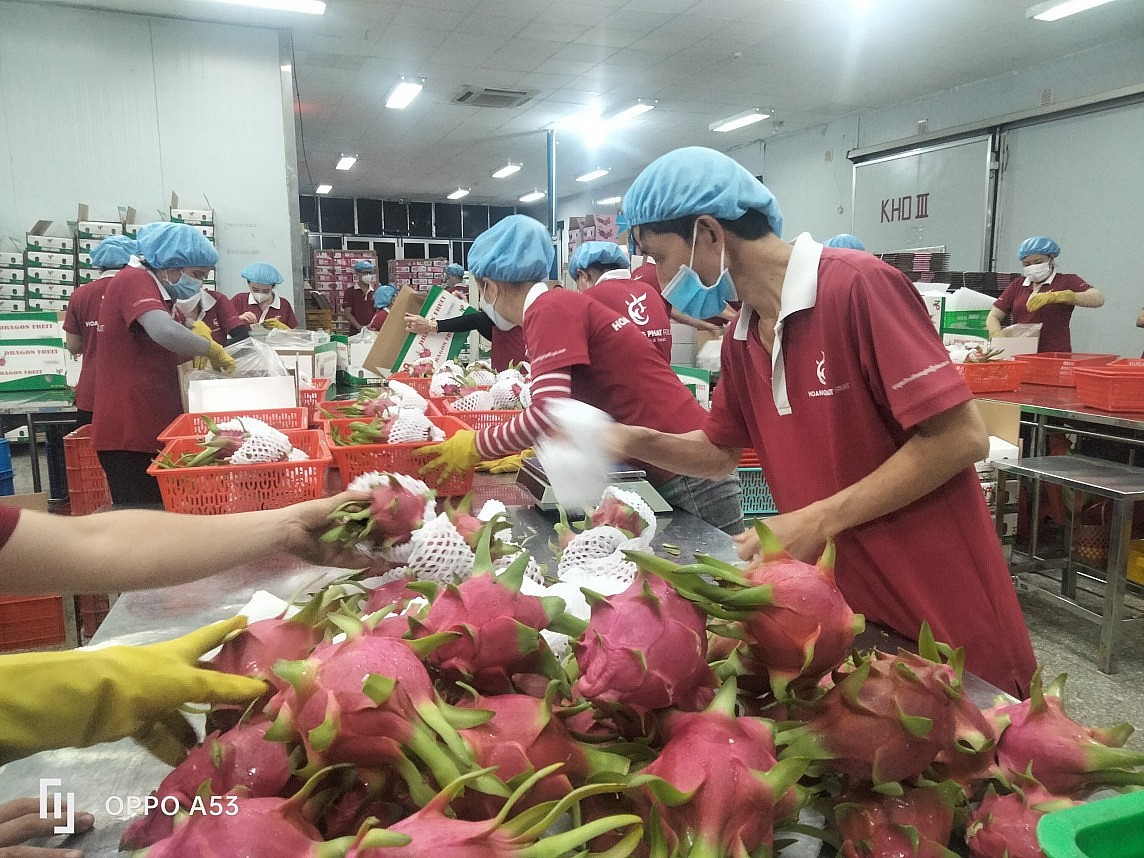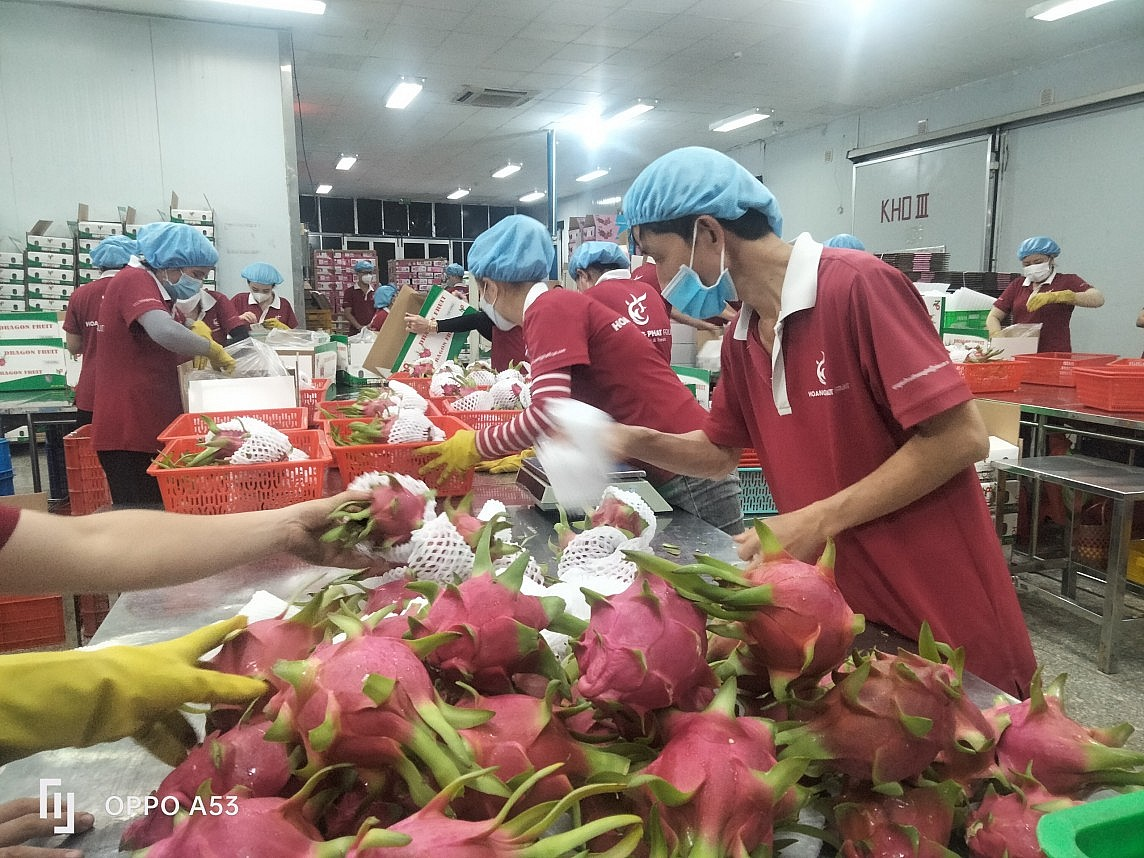Vietnam’s fruit and vegetable exports reached 1.804 billion USD in the first four months of 2024, a 32.1% increase year-on-year. Notably, durian and dragon fruit continued to be the two commodities with the highest export turnover.
Currently, the demand for Vietnamese fruits in traditional markets remains high. However, amidst prolonged heat and severe drought and salinity in the Mekong Delta provinces, fruit and vegetable production has been significantly affected. This has resulted in supply shortages, presenting challenges for export businesses.
Sharing insights on this issue, Mr. Nguyen Dinh Tung – General Director of Vina T&T Company, stated that despite the promising export performance in the first four months, many export businesses are facing difficulties due to skyrocketing freight rates.

Sorting dragon fruit for export. Photo: Ha Linh
Moreover, the hot weather has made fruit preservation more challenging. To maintain product quality, businesses have had to modify their operations, resulting in a 20-30% increase in operating costs alone. This has led to higher fruit and vegetable prices.
Most concerning is the severe heat and salinity in provinces such as Binh Thuan, Long An, and Tien Giang, which have significantly impacted export supply.
According to Mr. Tung, the supply of many items, such as fresh coconut and grapefruit, has declined sharply. In Ben Tre, grapefruit is scarce for export. Whereas previously, businesses only purchased grapefruit weighing 1 kg or more, now they must accept fruit weighing 0.6 kg or more.
“In the past, businesses could simply wait for traders to bring goods to them, but now they must actively source directly from the orchards. Notably, the scarcity of supply has forced companies to lower their selection standards to meet market demand,” said Mr. Tung.
For example, the current farm gate price of coconut in Ben Tre is 130,000 VND/10 coconuts, while the export price is over 200,000 VND. Previously, the price was as low as 40,000-50,000 VND/10 coconuts, indicating a three to four-fold increase.
“Export businesses are facing a fierce battle due to the scarcity of supply caused by the heat. The prices of all agricultural products are soaring. Coconut, for instance, is now more expensive than gold. The price can increase by 20-30% from morning to evening,” said Mr. Nguyen Dinh Tung, CEO of Vina T&T Group.
Given the declining supply and existing contracts with customers, businesses have had to increase their procurement prices to secure export supply. They have also introduced various support policies to encourage farmers to sell their produce to companies. Additionally, businesses have committed to purchasing during the off-season, ensuring stable sales throughout the year.
For existing contracts, businesses are willing to buy at higher prices to fulfill their obligations to customers. Consequently, they have been вынуждены to decline new orders due to insufficient supply.
Meanwhile, Mr. Nguyen Quoc Trinh, Chairman of the Long An Province Dragon Fruit Association, stated that due to the heat, dragon fruit yield and volume have decreased significantly, leading to a supply shortage.
According to Mr. Trinh, in the past, Long An could harvest approximately 100,000 tons of dragon fruit between May and August, but current production has dropped to around 50%.
Explaining the reasons for this decline, Mr. Trinh pointed to not only the extreme weather conditions but also the impact of the COVID-19 pandemic, which made it difficult for dragon fruit growers to sell their produce, leading them to switch to other crops.
Mr. Dang Phuc Nguyen, Secretary-General of the Vietnam Fruit and Vegetable Association, acknowledged that the drought and salinity in the Mekong Delta have compromised product quality, significantly affecting export supply. This is particularly concerning for key commodities like durian and dragon fruit, which require ample water but have been affected by drought conditions in Binh Thuan and Long An, resulting in poor fruit development or low yields.
For example, in Binh Thuan, the province’s total dragon fruit area currently stands at 26,500 hectares, a decrease of nearly 1,150 hectares compared to the same period in 2023. Additionally, since March 2024, many farmers have continued to use artificial lighting for off-season production, but the intense heat and strong winds have hindered flowering, leading to low yields.
“The supply shortage is not limited to Vietnam; other countries affected by climate change, such as Thailand and the Philippines, are also experiencing reduced fruit production,” said Mr. Nguyen, adding that the target of exporting 6 billion USD worth of fruit and vegetables remains feasible. This is because there is still a dragon fruit season to come before the end of 2024, while durian production in the southeastern region, including Dong Nai and the Central Highlands, remains stable.








































